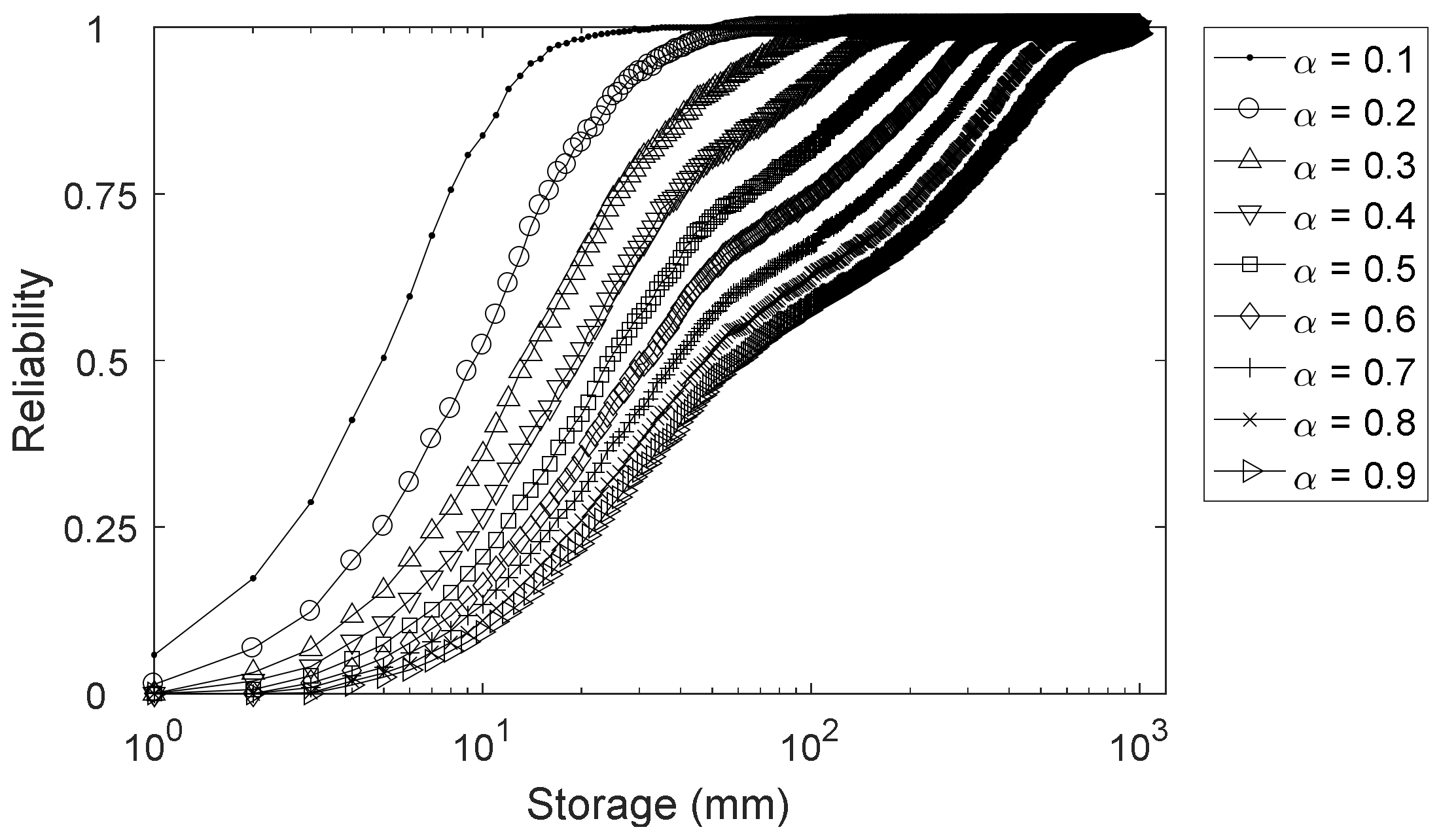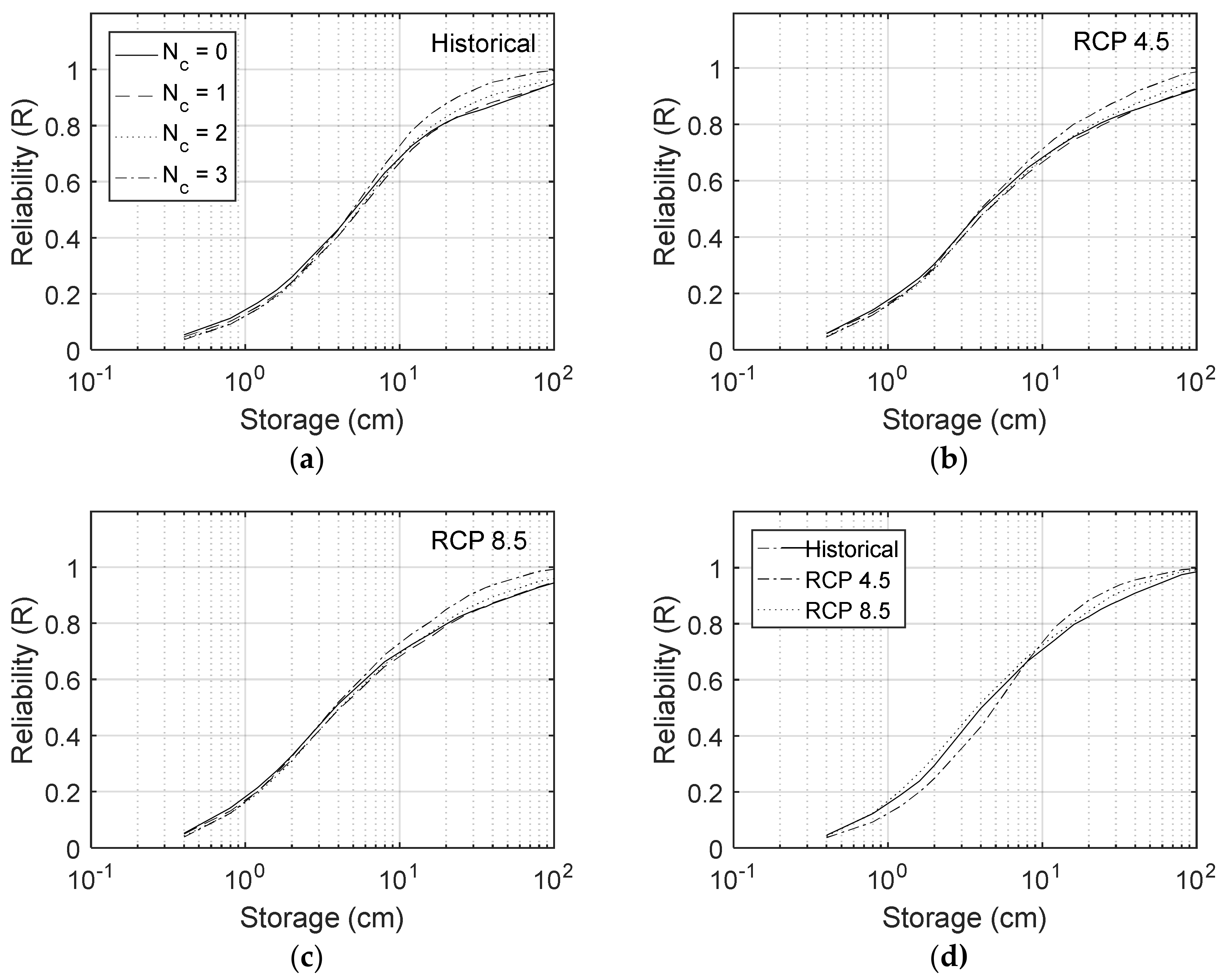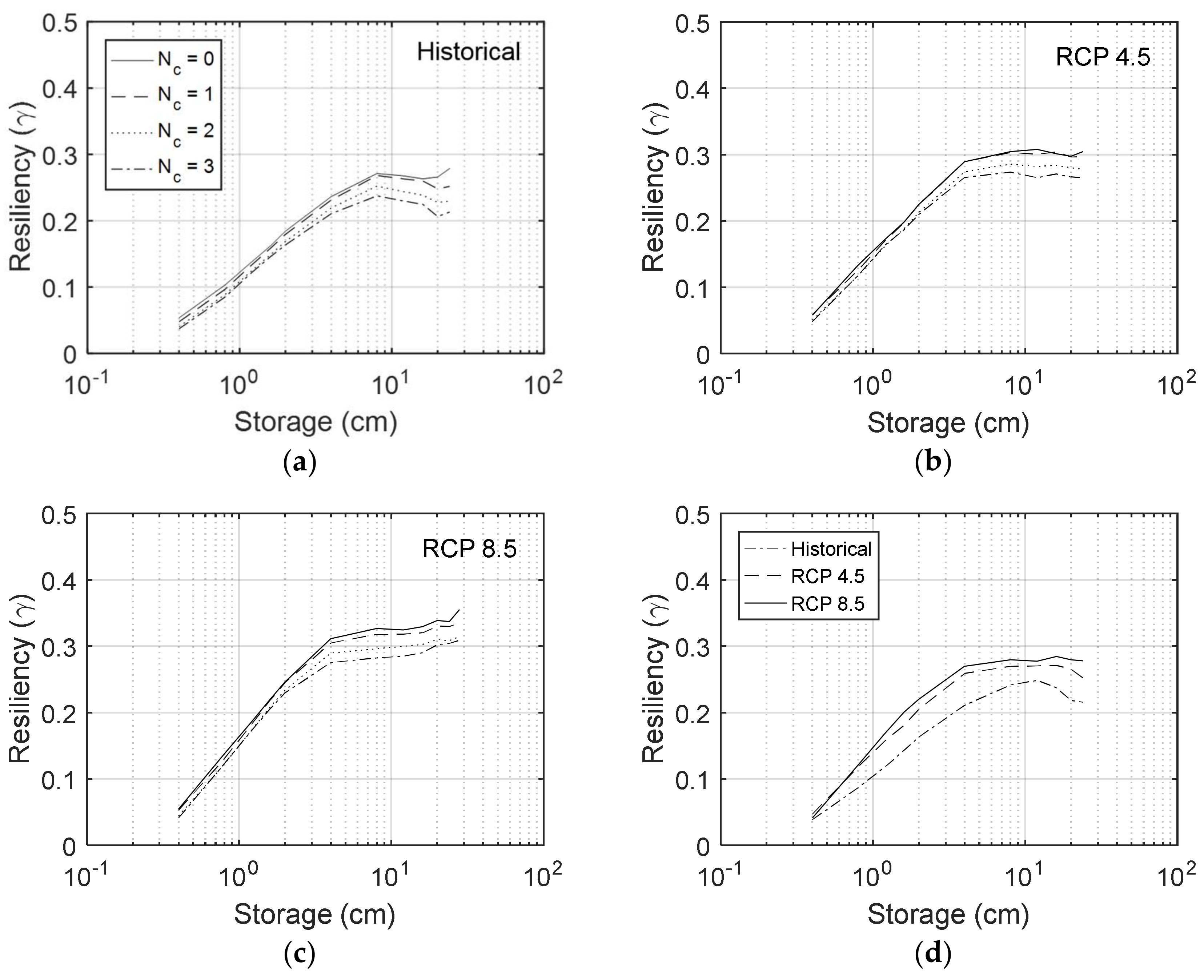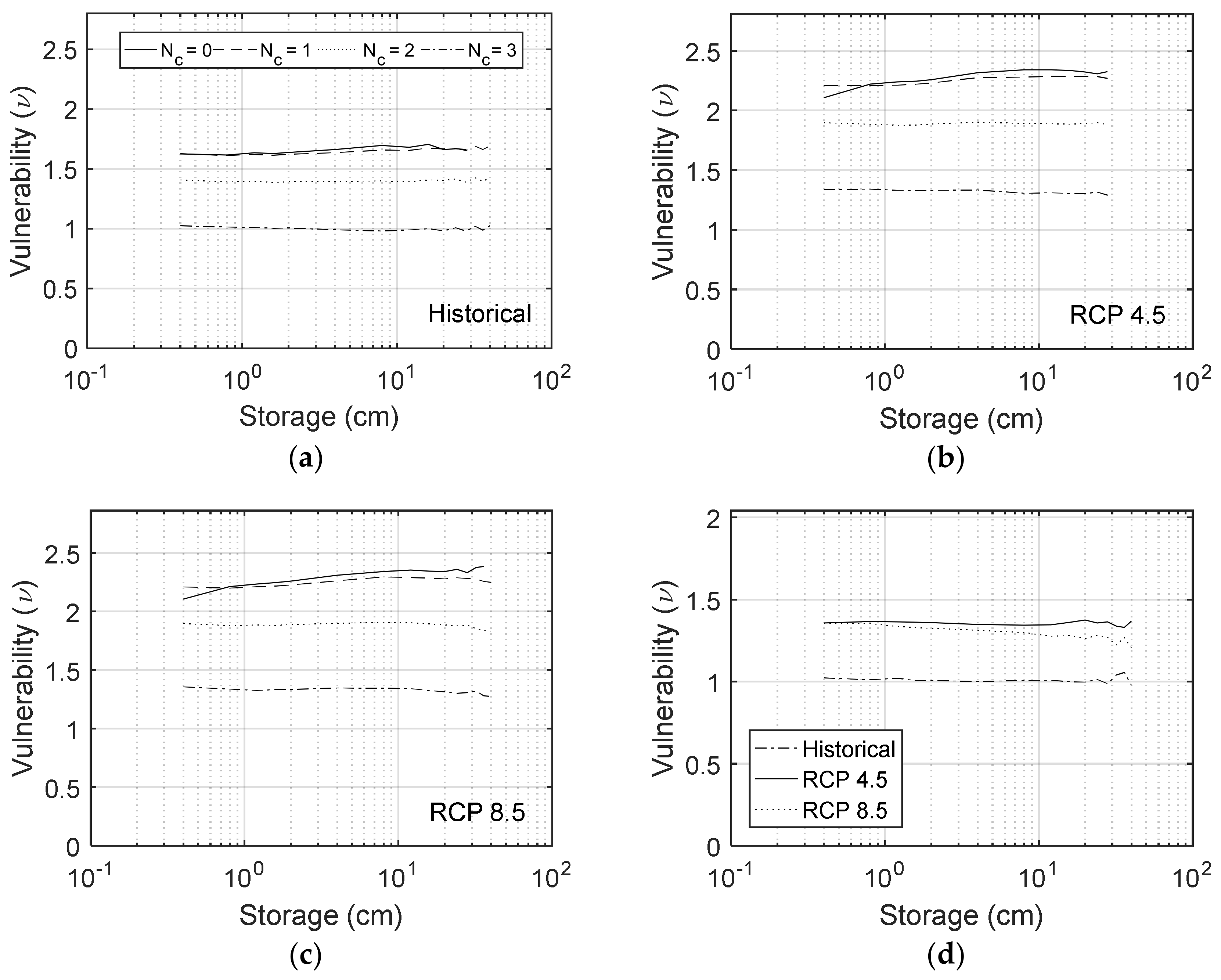Performance of a RBSN under the RCP Scenarios: A Case Study in South Korea
Abstract
:1. Introduction
2. Methods
2.1. Study Area and Corresponding RCP Scenarios
2.2. SRY Relation and a RBSN
2.3. Performance Criteria
3. Results and Discussion
3.1. Performance of a RBSN under the RCP Scenarios
3.2. Benefit of a RBSN Under RCP Scenarios
4. Conclusions
Acknowledgments
Author Contributions
Conflicts of Interest
References
- Pacey, A.; Cullis, A. Rainwater Harvesting: The Collection of Rainfall and Runoff in Rural Areas; ITDG Publishing: London, UK, 1986. [Google Scholar]
- Helmreich, B.; Horn, H. Opportunities in rainwater harvesting. Desalination 2009, 248, 118–124. [Google Scholar] [CrossRef]
- Stec, A.; Kordana, S. Analysis of profitability of rainwater harvesting, gray water recycling and drain water heat recovery systems. Resour. Conserv. Recycl. 2015, 105, 84–94. [Google Scholar] [CrossRef]
- Villarreal, E.L.; Dixon, A. Analysis of a rainwater collection system for domestic water supply in ringdansen, Norrkoping, Sweden. Build. Environ. 2005, 40, 1174–1184. [Google Scholar] [CrossRef]
- Campisano, A.; Butler, D.; Ward, S.; Burns, M.J.; Friedler, E.; DeBusk, K.; Fisher-Jeffes, L.N.; Ghisi, E.; Rahman, A.; Furumai, H.; et al. Urban rainwater harvesting systems: Research, implementation and future perspectives. Water Res. 2017, 115, 195–209. [Google Scholar] [CrossRef] [PubMed]
- Mahmood, A.; Hossain, F. Feasibility of managed domestic rainwater harvesting in South Asian rural areas using remote sensing. Resour. Conserv. Recycl. 2017, 125, 157–168. [Google Scholar] [CrossRef]
- Ward, S.; Memon, F.A.; Butler, D. Performance of a large building rainwater harvesting system. Water Res. 2012, 46, 5127–5134. [Google Scholar] [CrossRef] [PubMed]
- Jenkins, D.; Pearson, F.; Moore, E.; Sun, J.K.; Valentine, R. Feasibility of Rainwater Collection System in California; Contribution No. 173 California Water Resources Center, University of California: Oakland, CA, USA, 1978. [Google Scholar]
- Pelak, N.; Porporato, A. Sizing a rainwater harvesting cistern by minimizing costs. J. Hydrol. 2016, 541, 1340–1347. [Google Scholar] [CrossRef]
- Huang, C.-L.; Hsu, N.-S.; Wei, C.-C.; Luo, W.-J. Optimal spatial design of capacity and quantity of rainwater harvesting systems for urban flood mitigation. Water 2015, 7, 5173–5202. [Google Scholar] [CrossRef]
- Hanson, L.; Vogel, R.; Kirshen, P.; Shanahan, P.; Starrett, S. Generalized Storage-Reliability-Yield Equations Rainwater Harvesting Systems. In Proceedings of the World Environmental & Water Resources Congress, Kansas City, MO, USA, 17–21 May 2009; American Society of Civil Engineers: Kansas City, MO, USA, 2009; pp. 1–10. [Google Scholar]
- Sanches Fernandes, L.F.; Terêncio, D.P.S.; Pacheco, F.A.L. Rainwater harvesting systems for low demanding applications. Sci. Total Environ. 2015, 529, 91–100. [Google Scholar] [CrossRef] [PubMed]
- Terêncio, D.P.S.; Sanches Fernandes, L.F.; Cortes, R.M.V.; Moura, J.P.; Pacheco, F.A.L. Rainwater harvesting in catchments for agro-forestry uses: A study focused on the balance between sustainability values and storage capacity. Sci. Total Environ. 2018, 613–614, 1079–1092. [Google Scholar]
- Ndiritu, J.; Moodley, Y.; Guliwe, M. Generalized storage-yield-reliability relationships for analysing shopping centre rainwater harvesting systems. Water 2017, 9, 771. [Google Scholar] [CrossRef]
- Hajani, E.; Rahman, A. Reliability and cost analysis of a rainwater harvesting system in peri-urban regions of greater Sydney, Australia. Water 2014, 6, 945–960. [Google Scholar] [CrossRef]
- Lopes, V.A.R.; Marques, G.F.; Dornelles, F.; Medellin-Azuara, J. Performance of rainwater harvesting systems under scenarios of non-potable water demand and roof area typologies using a stochastic approach. J. Clean. Prod. 2017, 148, 304–313. [Google Scholar] [CrossRef]
- Vuong, N.M.; Ichikawa, Y.; Ishidaira, H. Performance assessment of rainwater harvesting considering rainfall variations in Asian tropical monsoon climates. Hydrol. Res. Lett. 2016, 10, 27–33. [Google Scholar] [CrossRef]
- Burns, M.J.; Fletcher, T.D.; Duncan, H.P.; Hatt, B.E.; Ladson, A.R.; Walsh, C.J. The performance of rainwater tanks for stormwater retention and water supply at the household scale: An empirical study. Hydrol. Process. 2015, 29, 152–160. [Google Scholar] [CrossRef]
- Asadieh, B.; Krakauer, N.Y. Impacts of Changes in Precipitation Amount and Distribution on Water Resources Studied Using a Model Rainwater Harvesting System. J. Am. Water Resour. Assoc. 2016, 52, 1450–1471. [Google Scholar] [CrossRef]
- Jafarzadeh, A.; Bilondi, M.P.; Afshar, A.A.; Yaghoobzadeh, M. Reliability estimation of rainwater catchment system using future GCM output data (case study: Birjand city). Eur. Water 2017, 59, 169–175. [Google Scholar]
- Lebel, S.; Fleskens, L.; Forster, P.M.; Jackson, L.S.; Lorenz, S. Evaluation of in situ rainwater harvesting as an adaptation strategy to climate change for maize production in rainfed Africa. Water Resour. Manag. 2015, 29, 4803–4816. [Google Scholar] [CrossRef]
- Haque, M.M.; Rahman, A.; Samali, B. Evaluation of climate change impacts on rainwater harvesting. J. Clean. Prod. 2016, 137, 60–69. [Google Scholar] [CrossRef]
- Seo, Y.; Choi, N.J.; Park, D. Effect of connecting rain barrels on the storage size reduction. Hydrol. Process. 2012, 26, 3538–3551. [Google Scholar] [CrossRef]
- Seo, Y.; Ahn, J.; Kim, Y.O. The impact of climate change on the benefit of a rain barrel sharing network. Resour. Conserv. Recyl. 2013, 74, 66–74. [Google Scholar] [CrossRef]
- IPCC. Climate Change 2014: Synthesis Report. Contribution of Working Groups i, ii and iii to the Fifth Assessment Report of the Intergovernmental Panel on Climate Change; IPCC: Geneva, Switzerland, 2014; p. 151. [Google Scholar]
- Seo, Y.; Park, S.Y.; Kim, Y.O. Potential benefits from sharing rainwater storages depending on characteristics in demand. Water 2015, 7, 1013–1029. [Google Scholar] [CrossRef]
- Noh, S.J.; Chung, E.S.; Seo, Y. Performance of a rain barrel sharing network under climate change. Water 2015, 7, 3466–3485. [Google Scholar] [CrossRef]
- Kim, M.-K.; Han, M.-S.; Jang, D.-H.; Baek, S.-G.; Lee, W.-S.; Kim, Y.-H.; Kim, S. Production technique of observation grid data of 1km resolution. J. Clim. Res. 2012, 7, 55–68. [Google Scholar]
- Kim, M.-K.; Lee, D.-H.; Kim, A.J. Production and validation of daily grid data with 1 km resolution in South Korea. J. Clim. Res. 2013, 8, 13–25. [Google Scholar]
- Hashimoto, T.; Stedinger, J.R.; Loucks, D.P. Reliability, resiliency, and vulnerability criteria for water resource system performance evaluation. Water Resour. Res. 1982, 18, 14–20. [Google Scholar] [CrossRef]









| Scenarios | Radiative Forcing (W/m2) | CO2-eq Concentration (ppm) | Description |
|---|---|---|---|
| RCP 2.6 | 3.0 | 480–530 | A strict reduction scenario that aims to keep global warming likely below 2 °C above pre-industrial temperatures. |
| RCP 4.5 | 4.5 | 580–720 | A reduction scenario in which a significant GHG mitigation policy is implemented. |
| RCP 6.0 | 6.0 | 720–1000 | A normal reduction scenario in which an ordinary GHG mitigation policy is implemented. |
| RCP 8.5 | 8.5 | >1000 | Very high GHG emissions. Scenarios without additional efforts to constrain emissions. |
| Nc | Scenarios | Possible Combinations |
|---|---|---|
| 1 | 11 | C1 = X1 + X2; C2 = X3; C3 = X4 |
| 12 | C1 = X1 + X3; C2 = X2; C3 = X4 | |
| 13 | C1 = X1 + X4; C2 = X2; C3 = X3 | |
| 14 | C1 = X1 + X3; C2 = X1; C3 = X4 | |
| 15 | C1 = X1 + X4; C2 = X1; C3 = X3 | |
| 16 | C1 = X1 + X4; C2 = X1; C3 = X2 | |
| 2 | 21 | C1 = X1 + X2 + X3; C2 = X4 |
| 22 | C1 = X1 + X2 + X4; C2 = X3 | |
| 23 | C1 = X1 + X3 + X4; C2 = X2 | |
| 24 | C1 = X2 + X3 + X4; C2 = X1 | |
| 25 | C1 = X1 + X2; C2 = X3 + X4 | |
| 26 | C1 = X1 + X4; C2 = X2 + X3 | |
| 27 | C1 = X1 + X3; C2 = X2 + X4 | |
| 3 | 31 | C1 = X1 + X2 + X3 + X4 |
| Region | Rainfall | Target Reliability (%) | ||||||
|---|---|---|---|---|---|---|---|---|
| 95 | 90 | 80 | 60 | 50 | 40 | 30 | ||
| Seoul | Historical | 62.0 | 59.3 | 31.5 | 7.9 | 4.5 | −0.7 | −4.8 |
| RCP 4.5 | 51.8 | 52.1 | 31.8 | 5.8 | 4.4 | −0.9 | −5.8 | |
| RCP 8.5 | 52.9 | 52.9 | 25.3 | 6.5 | 2.1 | −0.1 | −3.2 | |
| Busan | Historical | 57.8 | 50.8 | 23.8 | 8.9 | 2.7 | −0.9 | −4.9 |
| RCP 4.5 | 60.5 | 45.0 | 18.8 | 4.4 | 1.8 | −0.8 | −3.0 | |
| RCP 8.5 | 59.7 | 41.5 | 17.0 | 5.6 | 2.6 | −0.1 | −2.9 | |
| Daegu | Historical | 55.6 | 45.3 | 28.5 | 9.4 | 6.5 | 0.85 | −4.1 |
| RCP 4.5 | 59.6 | 47.0 | 19.5 | 5.2 | 0.7 | −1.8 | −5.7 | |
| RCP 8.5 | 60.8 | 39.4 | 22.5 | 5.2 | 3.2 | −0.4 | −3.4 | |
| Gwangju | Historical | 65.0 | 52.9 | 23.2 | 7.2 | 4.5 | 0.4 | −4.0 |
| RCP 4.5 | 63.3 | 45.6 | 18.9 | 5.2 | 2.9 | −0.1 | −2.7 | |
| RCP 8.5 | 60.6 | 35.2 | 19.1 | 7.4 | 2.9 | 1.0 | −2.9 | |
© 2018 by the authors. Licensee MDPI, Basel, Switzerland. This article is an open access article distributed under the terms and conditions of the Creative Commons Attribution (CC BY) license (http://creativecommons.org/licenses/by/4.0/).
Share and Cite
Kwon, Y.; Hwang, J.; Seo, Y. Performance of a RBSN under the RCP Scenarios: A Case Study in South Korea. Sustainability 2018, 10, 1242. https://doi.org/10.3390/su10041242
Kwon Y, Hwang J, Seo Y. Performance of a RBSN under the RCP Scenarios: A Case Study in South Korea. Sustainability. 2018; 10(4):1242. https://doi.org/10.3390/su10041242
Chicago/Turabian StyleKwon, Youjeong, Junshik Hwang, and Yongwon Seo. 2018. "Performance of a RBSN under the RCP Scenarios: A Case Study in South Korea" Sustainability 10, no. 4: 1242. https://doi.org/10.3390/su10041242





